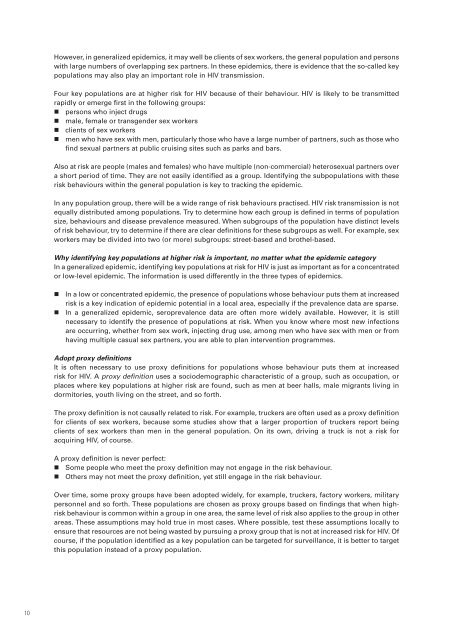Guidelines for second generation HIV surveillance - World Health ...
Guidelines for second generation HIV surveillance - World Health ...
Guidelines for second generation HIV surveillance - World Health ...
Create successful ePaper yourself
Turn your PDF publications into a flip-book with our unique Google optimized e-Paper software.
However, in generalized epidemics, it may well be clients of sex workers, the general population and persons<br />
with large numbers of overlapping sex partners. In these epidemics, there is evidence that the so-called key<br />
populations may also play an important role in <strong>HIV</strong> transmission.<br />
Four key populations are at higher risk <strong>for</strong> <strong>HIV</strong> because of their behaviour. <strong>HIV</strong> is likely to be transmitted<br />
rapidly or emerge first in the following groups:<br />
• persons who inject drugs<br />
• male, female or transgender sex workers<br />
• clients of sex workers<br />
• men who have sex with men, particularly those who have a large number of partners, such as those who<br />
find sexual partners at public cruising sites such as parks and bars.<br />
Also at risk are people (males and females) who have multiple (non-commercial) heterosexual partners over<br />
a short period of time. They are not easily identified as a group. Identifying the subpopulations with these<br />
risk behaviours within the general population is key to tracking the epidemic.<br />
In any population group, there will be a wide range of risk behaviours practised. <strong>HIV</strong> risk transmission is not<br />
equally distributed among populations. Try to determine how each group is defined in terms of population<br />
size, behaviours and disease prevalence measured. When subgroups of the population have distinct levels<br />
of risk behaviour, try to determine if there are clear definitions <strong>for</strong> these subgroups as well. For example, sex<br />
workers may be divided into two (or more) subgroups: street-based and brothel-based.<br />
Why identifying key populations at higher risk is important, no matter what the epidemic category<br />
In a generalized epidemic, identifying key populations at risk <strong>for</strong> <strong>HIV</strong> is just as important as <strong>for</strong> a concentrated<br />
or low-level epidemic. The in<strong>for</strong>mation is used differently in the three types of epidemics.<br />
• In a low or concentrated epidemic, the presence of populations whose behaviour puts them at increased<br />
risk is a key indication of epidemic potential in a local area, especially if the prevalence data are sparse.<br />
• In a generalized epidemic, seroprevalence data are often more widely available. However, it is still<br />
necessary to identify the presence of populations at risk. When you know where most new infections<br />
are occurring, whether from sex work, injecting drug use, among men who have sex with men or from<br />
having multiple casual sex partners, you are able to plan intervention programmes.<br />
Adopt proxy definitions<br />
It is often necessary to use proxy definitions <strong>for</strong> populations whose behaviour puts them at increased<br />
risk <strong>for</strong> <strong>HIV</strong>. A proxy definition uses a sociodemographic characteristic of a group, such as occupation, or<br />
places where key populations at higher risk are found, such as men at beer halls, male migrants living in<br />
dormitories, youth living on the street, and so <strong>for</strong>th.<br />
The proxy definition is not causally related to risk. For example, truckers are often used as a proxy definition<br />
<strong>for</strong> clients of sex workers, because some studies show that a larger proportion of truckers report being<br />
clients of sex workers than men in the general population. On its own, driving a truck is not a risk <strong>for</strong><br />
acquiring <strong>HIV</strong>, of course.<br />
A proxy definition is never perfect:<br />
• Some people who meet the proxy definition may not engage in the risk behaviour.<br />
• Others may not meet the proxy definition, yet still engage in the risk behaviour.<br />
Over time, some proxy groups have been adopted widely, <strong>for</strong> example, truckers, factory workers, military<br />
personnel and so <strong>for</strong>th. These populations are chosen as proxy groups based on findings that when highrisk<br />
behaviour is common within a group in one area, the same level of risk also applies to the group in other<br />
areas. These assumptions may hold true in most cases. Where possible, test these assumptions locally to<br />
ensure that resources are not being wasted by pursuing a proxy group that is not at increased risk <strong>for</strong> <strong>HIV</strong>. Of<br />
course, if the population identified as a key population can be targeted <strong>for</strong> <strong>surveillance</strong>, it is better to target<br />
this population instead of a proxy population.<br />
10
















